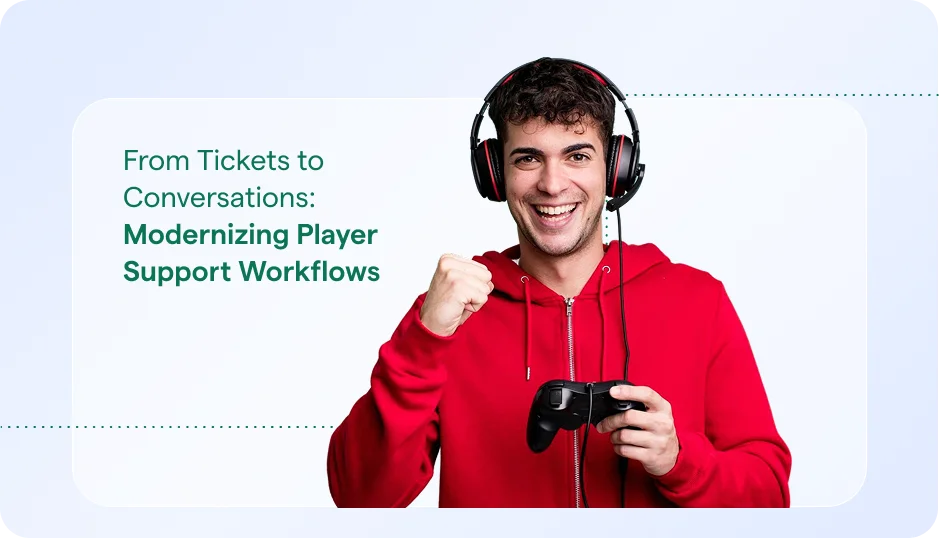The gaming industry has reached an inflection point. With global gaming revenue projected to exceed $200 billion and player expectations at an all-time high, traditional email support is no longer sufficient for modern gaming companies. Players today demand instant, contextual, and seamless support experiences that don’t interrupt their gameplay flow.
The shift from email to in-game support isn’t just a trend—it’s a fundamental evolution in how gaming companies approach customer service. Let’s explore why in-game support is becoming the gold standard for gaming customer experience and how it directly impacts player retention, satisfaction, and your bottom line.
The Problem with Email Support in Gaming
Email support, while still widely used across industries, presents unique challenges in the gaming environment that can severely impact player experience and business metrics.
Context Loss and Delayed Resolution
When players encounter issues during gameplay, they’re often in the middle of critical moments—whether it’s a competitive match, raid, or time-sensitive event. Switching to email means losing the immediate context of their problem. Players must remember specific details, describe complex in-game situations through text, and wait hours or days for responses. This delay can turn minor frustrations into game-breaking experiences that drive players away permanently. Real-time customer support addresses these critical timing issues that email simply cannot handle.
Broken Player Flow and Immersion
Gaming is fundamentally about immersion and engagement. Every second a player spends outside your game environment is a risk. Email support forces players to leave their gaming session, open external applications, compose detailed messages, and then wait indefinitely. This disruption breaks the carefully crafted player experience that game developers spend millions creating. In-app messaging solutions eliminate this friction by keeping support conversations within the game environment.
Limited Technical Context
Email support agents often struggle to understand complex gaming issues without proper context. Players attempt to describe technical problems through screenshots or lengthy explanations, but agents can’t see the player’s current state, game logs, or account information in real-time. This leads to prolonged back-and-forth exchanges and frustrated players who feel misunderstood. Comprehensive ticket management systems provide agents with the complete player context needed for efficient problem resolution.
The In-Game Support Advantage
In-game support transforms customer service from a necessary evil into a seamless extension of the player experience. Here’s how it revolutionizes gaming support:
Instant Access and Real-Time Resolution
Players can access support directly within the game interface without interrupting their session. Whether they’re stuck on a level, experiencing a payment issue, or encountering a bug, help is just a tap away. This immediacy is crucial for maintaining player engagement and preventing frustration from escalating.
Contextual Understanding
In-game support systems can access real-time player data, including current game state, recent actions, account information, and technical logs. This contextual awareness enables support agents to understand issues immediately and provide targeted solutions without requiring players to explain complex scenarios.
Rich Media Support for Complex Issues
Gaming problems often require visual explanation. In-game support allows players to share screenshots, videos, and even screen recordings directly from their gaming session. Support agents can see exactly what players are experiencing, dramatically reducing resolution time and improving accuracy. Modern platforms offer rich media support capabilities that make complex issue resolution straightforward and efficient.
Seamless Integration with Game Systems
Modern in-game support platforms can integrate directly with game backend systems, allowing agents to perform actions like account recovery, inventory restoration, or bug fixes without requiring players to provide extensive verification or wait for manual processes. Advanced integration capabilities enable support teams to resolve issues that would typically require multiple departments and lengthy email chains.
Impact on Key Gaming Metrics
The switch to in-game support creates measurable improvements across critical gaming business metrics that directly impact revenue and growth.
Player Retention and Lifetime Value
Studies show that players who receive quick, effective support are 40% more likely to continue playing and spend 25% more on in-app purchases over their lifetime. In-game support reduces the friction between problem and solution, keeping players engaged during critical moments when they might otherwise quit.
Support Efficiency and Cost Reduction
In-game support typically reduces average resolution time by 60-70% compared to email support. With full context and integrated tools, agents can resolve issues faster, handle more tickets per hour, and focus on complex problems rather than information gathering. This efficiency translates directly to reduced support costs and improved agent productivity.
Player Satisfaction and Review Scores
Players consistently rate in-game support experiences higher than traditional email support. The convenience, speed, and contextual understanding create positive support experiences that often result in improved app store ratings and positive word-of-mouth marketing.
Case Study: Mobile RPG Transforms Support Experience
A popular mobile RPG with over 10 million downloads was struggling with email support inefficiencies. Players frequently abandoned the game after encountering account issues, and support ticket resolution averaged 48 hours. The company’s email support team was overwhelmed with repetitive questions about account recovery, payment problems, and gameplay bugs.
After implementing in-game support, the transformation was immediate and dramatic. The new system provided agents with real-time access to player accounts, game states, and technical logs. Players could initiate support conversations directly from the game interface and receive help without leaving their gaming session. For complex issues, players could share screenshots and videos instantly, eliminating the need for lengthy email descriptions.
The AI-powered chatbot system handled 70% of common inquiries automatically, including account recovery assistance, FAQ responses, and basic troubleshooting. When human intervention was needed, agents had complete context and could resolve issues in minutes rather than hours. The system also enabled proactive support, automatically detecting when players encountered known bugs and offering immediate assistance.
Results were compelling across all metrics. Average resolution time dropped from 48 hours to under 15 minutes for common issues. Player satisfaction scores increased by 45%, and most importantly, player retention improved by 30% among users who interacted with the new support system. The company also saw a 25% reduction in support costs due to increased efficiency and automation capabilities.
The seamless experience transformed support from a pain point into a competitive advantage, with players frequently praising the responsive, helpful support system in their app store reviews.
Technical Advantages of Modern In-Game Support
Today’s in-game support platforms offer sophisticated capabilities that far exceed traditional email systems, particularly for gaming environments.
AI-Powered Automation
Modern in-game support systems leverage AI to handle routine inquiries automatically. Chatbots can guide players through account recovery, answer common questions about gameplay mechanics, and even troubleshoot technical issues. This automation ensures 24/7 availability while freeing human agents to focus on complex problems requiring personal attention. Automated issue resolution capabilities can handle up to 80% of common gaming support inquiries without human intervention.
Multilingual Support
Global games require support in multiple languages. Advanced in-game support platforms offer real-time translation capabilities, enabling support agents to communicate effectively with players worldwide. This global accessibility is crucial for international gaming companies expanding into new markets. Multilingual support solutions break down language barriers and ensure consistent support quality across all player demographics.
Integration Capabilities
In-game support systems can integrate with existing game infrastructure, including player databases, payment systems, and analytics platforms. This integration enables comprehensive support capabilities and ensures agents have access to all relevant player information during support interactions.
Analytics and Performance Tracking
Unlike email support, in-game support platforms provide detailed analytics on support interactions, resolution times, player satisfaction, and common issue patterns. This data enables continuous improvement and helps identify areas where additional automation or training might be beneficial. Advanced analytics and reporting transform support from a cost center into a strategic advantage by providing actionable insights for game improvement and player retention.
Implementation Considerations
Successfully transitioning to in-game support requires careful planning and consideration of your specific gaming environment and player base.
User Interface Design
The support interface must feel native to your game while remaining easily accessible. Players should be able to access support without disrupting their gameplay flow, and the interface should match your game’s visual style and user experience patterns. Customizable in-app messaging interfaces ensure support feels like a natural extension of your game rather than an external interruption.
Agent Training and Tools
Support agents need training on gaming-specific issues and access to comprehensive tools for resolving player problems. This includes understanding game mechanics, common player pain points, and how to use integrated backend systems effectively.
Escalation Processes
While in-game support handles most issues effectively, complex problems may require escalation to specialized teams or developers. Clear escalation processes ensure that difficult issues receive appropriate attention without creating bottlenecks.
Performance Monitoring
Regular monitoring of support performance metrics helps identify areas for improvement and ensures the system continues meeting player expectations as your game evolves.
The Future of Gaming Support
The evolution toward in-game support represents a broader shift in gaming customer experience expectations. Players increasingly expect the same level of convenience and personalization they receive from other digital services.
Predictive Support
Advanced analytics and AI will enable proactive support, automatically detecting when players are likely to encounter problems and offering assistance before issues become frustrating. This predictive approach will further improve player experience and reduce support burden.
Voice and Visual Support
As technology advances, in-game support will incorporate voice commands and visual recognition capabilities, making support interactions even more natural and seamless within the gaming environment.
Community Integration
Future in-game support systems will better integrate community features, allowing experienced players to help newcomers while maintaining professional support oversight for complex issues.
| Feature | In-Game Support | Email Support |
|---|---|---|
| Response Time | Instant, real-time responses | Hours to days delay |
| Player Experience | Seamless, no gameplay interruption | Breaks immersion, requires external apps |
| Context Awareness | Full access to game state, player data, logs | Limited context, relies on player descriptions |
| Availability | 24/7 within game environment | Business hours limitation, external access required |
| Issue Resolution Speed | Average 15 minutes for common issues | Average 48+ hours for basic issues |
| Media Support | Rich media: screenshots, videos, screen recordings | Limited to text descriptions and attachments |
| Player Retention Impact | 30% improvement in retention rates | Higher abandonment during support process |
| Cost Efficiency | 60-70% faster resolution, reduced operational costs | Higher per-ticket costs due to lengthy exchanges |
| Automation Potential | AI chatbots handle 70-80% of inquiries | Limited automation, mostly manual responses |
| Integration Capabilities | Direct game backend integration | Requires manual verification and external tools |
| Language Support | Real-time translation, multilingual AI | Requires multilingual agents or translation delays |
| Scalability | Unlimited concurrent support sessions | Limited by agent availability |
| Player Satisfaction | 45% higher satisfaction scores | Lower satisfaction due to delays and friction |
| Technical Complexity | Advanced: game state analysis, real-time data | Basic: text-based communication only |
| Mobile Optimization | Native mobile integration | Separate email apps, poor mobile experience |
| Proactive Support | AI-driven issue prediction and prevention | Purely reactive, waits for player complaints |
| Community Features | Integrated with game social features | Isolated from gaming community |
| Analytics & Insights | Detailed player behavior and support analytics | Limited reporting, basic ticket metrics |
| Setup Complexity | Higher initial implementation effort | Quick setup, familiar infrastructure |
| Agent Training | Gaming-specific training required | General customer service skills sufficient |
| Escalation Process | Seamless in-game escalation to specialists | External escalation, context loss |
| Security & Privacy | Secure in-game authentication | Email security vulnerabilities |
| Player Verification | Automatic account verification | Manual verification processes |
| Issue Tracking | Real-time progress tracking within game | Email thread tracking, external systems |
| Cross-Platform Support | Consistent experience across all platforms | Platform-dependent email clients |
| Business Impact | Direct revenue impact through retention | Indirect impact, potential revenue loss |
Conclusion
The choice between email and in-game support isn’t just about convenience—it’s about recognizing that gaming is a unique medium requiring specialized support approaches. In-game support keeps players engaged, reduces friction, and creates positive experiences that drive retention and revenue growth.
As player expectations continue evolving and competition intensifies, gaming companies that cling to outdated email support systems risk losing players to competitors offering more seamless, responsive support experiences. The investment in in-game support technology pays dividends through improved player satisfaction, reduced support costs, and stronger business metrics across the board.
The future belongs to gaming companies that understand their players’ needs and deliver support experiences that enhance rather than interrupt the gaming journey. In-game support isn’t just better than email—it’s becoming essential for competitive success in the modern gaming landscape.
Ready to transform your gaming support experience? Learn more about Helpshift’s in-game support solutions and discover how leading gaming companies are revolutionizing their customer service approach.








